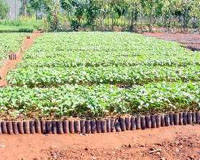 |
92nd Air Refueling Wing Public Affairs Fairchild AFB WA (AFNS) Feb 26, 2010 Airmen at Fairchild Air Force Base opened an E85 pump for use by certain government vehicles Feb. 10 in an effort to cut emissions and reduce their carbon footprint. E85 is an alternative fuel made primarily of corn and the E stands for ethanol and the 85 indicates the percentage. This fuel is made of 85 percent ethanol and 15 percent traditional gasoline. "U.S. Department of Energy defines E85 as an alternative fuel," said Tech. Sgt. Michael Ostrander, of the 92nd Logistics Readiness Squadron. "Besides its superior performance characteristics, ethanol burns cleaner than gasoline; it is a completely renewable, domestic, environmentally friendly fuel that enhances the nation's economy and energy independence." In 2005, Congress passed and former President George W. Bush signed the Energy Policy Act, requiring federal vehicles capable of operating on alternative fuels be run exclusively on these fuels and to conform to Presidential Executive Order 13123: Greening the Government through Efficient Energy Management. Because of this, about 153 of the 372 Fairchild AFB-assigned vehicles will now run on biodiesel or E85, environmentally friendly alternative fuels, said Danny Kiter of the 92nd LRS. At the moment, 44 of the wing's vehicles can use E85 and 109 vehicles are using B20, a biodegradable fuel that burns cleanly and is made from a renewable source. "Government tests have shown that E85 vehicles reduce harmful hydrocarbon and benzene emissions when compared to vehicles running on gasoline," Mr. Kiter said. "E85 can also reduce carbon dioxide, a harmful greenhouse gas and a major contributor to global warming. Although CO2 is released during ethanol production and combustion, it is recaptured as a nutrient to the crops that are used in its production. "Unlike fossil fuel combustion which unlocks carbon that has been stored for millions of years, use of ethanol results in low increases to the carbon cycle. Ethanol also degrades quickly in water and, therefore, poses much less risk to the environment than an oil or gasoline spill." While many changes are being made to help reduce our impact on the climate, this is the beginning of long-term environmental change at Fairchild AFB. "Today, the U. S. imports more than half of its oil, and overall consumption continues to increase," Mr. Kiter said. "The benefit outside of Fairchild (AFB) for the Spokane community is an environmentally friendly military installation and people in the community will know we care about the environment and are committed to using alternate fuel sources when available to help the environment."
Share This Article With Planet Earth
Related Links Fairchild Air Force Base Bio Fuel Technology and Application News
 China shrub shows biofuel promise
China shrub shows biofuel promiseBeijing (UPI) Feb 23, 2009 China's poisonous jatropha shrub is showing promise as biofuel and could boost the country's efforts to reduce dependency on imported crude oil. In the past, farmers planted the poisonous perennial only as a barrier to ward off animals from their fields. But Hong Kong-invested Shenyu New Energy Co. Ltd. sees the lush green shrub as a great moneymaker, with the potential to generate $59 ... read more |
|
| The content herein, unless otherwise known to be public domain, are Copyright 1995-2010 - SpaceDaily. AFP and UPI Wire Stories are copyright Agence France-Presse and United Press International. ESA Portal Reports are copyright European Space Agency. All NASA sourced material is public domain. Additional copyrights may apply in whole or part to other bona fide parties. Advertising does not imply endorsement,agreement or approval of any opinions, statements or information provided by SpaceDaily on any Web page published or hosted by SpaceDaily. Privacy Statement |